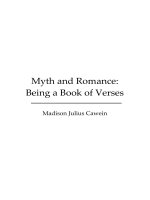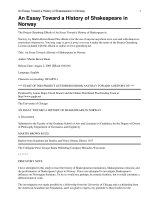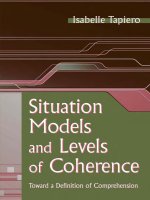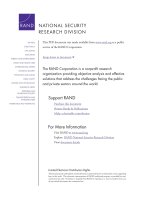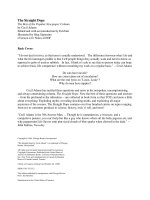temple univ pr food and evolution toward a theory of human food habits jan 1987
Bạn đang xem bản rút gọn của tài liệu. Xem và tải ngay bản đầy đủ của tài liệu tại đây (33.11 MB, 645 trang )
FOOD
AND
EVOLUTION
Toward a Theory of Hllman Food HabitsAND
EVOLUTION
Toward
a Theory
of
Human
Food
Habits
EDITED
BY
MAR'VIN
HARRIS
AND
ERIC
B.
ROSS
[iijiiJ
TEMPLE UNIVERSITY PRESS
~
Philadelphia
Temple University Press, Philadelphia 19122
Copyright
© 1987 by Temple University.
All
rights reserved
Published 1987
Printed
in
the United States of America
The paper used
in
this publication meets the minimum requirements of
American National Standard for Information
Sciences-
Permanence of
Paper for Printed Library Materials, ANSI 239.48-1984
Library
of
Congress
Cataloging-in-Publication
Data
Food and evolution.
Includes bibliographies and indexes.
1.
Food habits.
2.
Human evolution.
3.
Nutrition-Social
aspects.
4.
Man,
Primitive-Food.
I. Harris, Marvin,
1927-
II.
Ross, Eric
B.
[DNLM:
1.
Food Habits. GT 2860 F686]
GN407. F65 1986 306 86-5773
ISBN 0-87722-435-8 (alk. paper)
Although now substantially revised, the initial drafts of the papers
in
this volume were
presented at the 94th Symposium of the Wenner-Gren Foundation for Anthropological
Research at Cedar
Key,
Florida, October 23-30, 1983. On behalf of
all
the participants,
the editors wish to thank the foundation and its staff for their support and advice.
We
were especially aware of our debts to Lita Osrnundsen, the foundation's director of
research.
The editors are also deeply grateful to the staff of Temple University Press, es-
pecially to Jane Cullen, Jennifer French, and Jane Barry for their heroic production and
copyediting feats.
Part
I.
Theoretical Overview
1.
An Overview of
Trends
in
Dietary Vlriation from
Hunter-Gatherer
to
Modern
Capitalist Societies
ERIC
B.
ROSS
2.
Foodways: Historical Overview and Theoretical
Prolegomenon MARVIN HARRIS
Part
II.
Bioevolutionary
Antecedents
and Constraints
3.
Primate
Diets
and Gut Morphology: Implications for
Hominid Evolution KATHi\RINE MILTON
4.
Omnivorous
Primate
Diets and Human
Overconsumption of
Meat
WILLIAM]. HAMILTON
III
5.
Fava
Bean
Consumption: A
Case
for
the
Co-
Evolution of
Genes
and Culture
SOL()MON
H.
KATZ
Part
III.
Nutritional and Biopsychological Constraints
6.
Problems and Pitfalls in
the
Assessment
of Human
Nutritional
Status
P.
L.
PELLETT
7.
Psychobiological
Perspectives
on Food
Preferences
and Avoidances PAUL ROZIN
8.
The
Preference
for Animal
Protein
and f'at: A
Cross-Cultural
Survey
H.
LEOr~
ABRAMS, JR.
1
7
57
93
117
133
163
181
207
Vll
Contents
9.
Biocultural Consequences of Animals Versus Plants
225
as
Sources of Fats, Proteins, and
Other
Nutrients
LESLIE SUE LIEBERMAN
Part
IV.
Pre-State
Foodways:
Past
and
Present
10.
The
Significance of Long-Term Changes
in
Human
261
Diet and Food Economy MARK
N.
COHEN
11.
Life in
the
"Garden of Eden":
Causes
and
285
Consequences of
the
Adoption of Marine Diets by
Human Societies
DAVID
R.
YESNER
12.
The
Analysis of
Hunter-Gatherer
Diets: Stalking an
311
Optimal Foraging Model
BRUCE WINTERHALDER
13.
How Much Food Do
Foragers
Need?
341
KRISTEN HAWKES
14.
Aboriginal Subsistence in a Tropical Rain
Forest
357
Environment: Food Procurement, Cannibalism, and
Population Regulation
in
Northeastern
Australia
DAVID
R.
HARRIS
15.
Ecological and Structural Influences on
the
387
Proportions of Wild Foods in the Diets of Two
Machiguenga Communities ALLEN JOHNSON
and MICHAEL BAKSH
16.
Limiting Factors in Amazonian Ecology
407
KENNETH
R.
GOOD
Part
V.
The
Political Economy and the Political Ecology of
Contemporary Foodways
17.
Loaves and Fishes in Bangladesh
427
SHIRLEY LINDENBAUM
18.
Animal Protein Consumption and
the
Sacred Cow
445
Complex
in
India
K.
N.
NAIR
VIn
19.
The
Effects of Colonialism and Neocolonialism on the
Gastronomic Patterns of the Third 'Vorld
RICHARD
W.
FRANKE
20. Stability and Change
in
Highland Andean Dietary
Patterns BENjAlvlIN
S.
ORLOVE
21. Social Class and Diet
in
Contemporary Mexico
GRI~TEL
H.
PELTO
22. From Costa Rican Pasture to North American
Hamburger
Mi\RC EDELMAN
Part
VI.
Discussion and Conclusions
23.
The
Evolution of Human Subsistence
ANl'~A
ROOSEVELT
24. Biocultural Aspects of Food Choice
GEORGE ARMELAGOS
Mterword
About the Contributors
Glossary
Name Index
Subject Index
Contents
455
481
517
541
565
579
595
601
607
613
625
IX
AN
INTER_DISCIPLINARY EFFORT TO AD-
vance our understanding of why human beings
in
differing times and places
eat
what they do. It begins, at the
most
fundamental level, with the collective view
of the editors and
other
contributors that knowledge and comprehension of
human foodways, and the web of practices and beliefs associated with them,
must depend upon our seeking general principles and
recurrent
processes be-
neath the immediate appearance of a worldwide confusion of seemingly ca-
pricious preferences, avoidances, and aversions.
Once this decision is made, however, a complex
set
of explanatory strat-
egies and options still remains to be explored and integrated, since the knowl-
edge we have of human food customs and practices derives from data collection
that has traditionally
been
dispersed among varied specialties and theoretical
strategies.
We
cannot claim that
all
the relevant disciplines
or
all
the salient
levels of analysis and perspective are
represented
in
the chapters that
follow,
nor do we presume that this work encompasses an adequate representation of
those that are. But we hope at least to have helped to broaden the general
scope of inquiry beyond the horizons of any single viewpoint, while still main-
taining what we emphatically regard as a commitment to a nomothetic
approach.
The disciplinary perspectives of the contlibutors to this volume range over
primatology (Hamilton, Milton), nutrition (Pellett, Lieberman), biological an-
thropology (Armelagos, Katz), archaeology (Yesner, Cohen, Roosevelt,
D.
Harris), psychology (Rozin), and agricultural economics (Nair). Although cultur-
al
anthropologists predominate numerically, they too offer a great diversity of
insight and information based on their varying professional interests and,
in
particular, their wide spectrum of regional specializations: Bangladesh (Linden-
baum), Amazonia (Johnson and Baksh, Good, Ross), Paraguay (Hawkes), Ca-
nadian sub-arctic (Winterhalder), Southeast Asia and Africa (Franke), Mexico
(Pelto), Costa Rica (Edelman), Peru (Orlove), and Europe (Ross).
In attempting to integrate the diversity of disciplinary viewpoints that
these
scholars represent, the editors chose an evolutionary framework as the only
suitably broad
yet
coherent and unifying one available to us. In its biological
dimensions, at least, it
seemed
self-evident that the core of human dietary
practice,
all
subsequent embellishment aside,
must
be regarded
in
terms
of the
1
Introduction
emergence of the hominidae and the co-evolution of human diet and our phys-
ical
potential for cultural behavior. It
seems
likely,
for example, that hunting for
vertebrates, increased meat consumption, and expanded tool use
were
impli-
cated
in
the evolutionary processes that led to the expansion and reorganiza-
tion of the australopithecine brain and to the development
of
Homo's unique
capacities for consciousness and semantic universality.
There
is, at least, little
doubt that, throughout most of the Pleistocene, the evolution of biological rep-
ertoires and the evolution of behavioral repertoires were closely
intertwined-
and that diet is one domain where the intersection was particularly noteworthy.
With the appearance of
Homo
sapiens,
if
not earlier, however, a pro-
gressively
greater
independence-or
lag-between
biological and cultural se-
lection reduced the rate and incidence of gene-culture co-evolution. Radically
different modes of production, accompanied by massive changes
in
food habits,
emerged
in
the later phases of human prehistory and throughout subsequent
history without any discernible evidence of related changes
in
gene frequen-
cies. Increasingly, behavior associated with the procurement, distribution, and
consumption of food came, like the
rest
of human behavior, to be propagated
through learning
rather
than genetic replication. And although selection based
on consequences for reproductive success continued to operate, it was in-
creasingly supplemented,
if
not displaced, by selection based on the more im-
mediate consequences for the satisfaction of biopsychological needs and drives.
Though the feedback between
these
two levels of selection became
in-
creasingly indirect and delayed, the biological level still cannot be excluded
from our attempt to understand general as well as particular aspects of the
evolution of foodways. Indeed,
in
a small number of cases such as that of fava
bean (see Chapter
5)
and milk consumption, specific preferences and avoid-
ances continue to be associated with genetic polymorphisms found with varying
frequencies among different populations.
In evolutionary perspective, however, most of the great changes
in
human
diet can be more readily associated with shifts
in
modes of production that are
not
in
tum
linked to such genetic variations.
The
transition from upper paleo-
lithic to neolithic modes of production, for example, generally involved a shift
from narrow reliance on animal foods to broad-spectrum regimens
in
which the
consumption of domesticated tubers and grains gained ascendancy over meat
and other animal foods (pastoral modes of production, of course, followed a
divergent trajectory).
The
next great general evolutionary changes
in
foodways
may be associated with the rise ofarchaic agro-managerial
states
whose dense,
socially stratified populations
were
dependent on one
or
two staple grains and
which maintained distinctive consumption patterns for elites and commoners.
The further evolution of imperial
state
systems with massive potentials for
trade and great capacities for modifying their habitats through public works
doubtless increased such class
or
caste distinctions
in
dietary practice and gave
2
Introduction
rise to new rural/urban and core/periphery distinctions.
These
effects of politi-
cal-economic evolution and of
ever
more formidable political-ecological integra-
tion
finally
attained global proportions with the emergence of the capitalist
world system, leading
in
our own times to a return to highly carnivorous diets
for privileged regions and classes at the cost of impoverished diets and often de
facto vegetarianism
in
dependent and underdeveloped areas.
The contributions to this volume have been arranged with
these
broad evolu-
tionary considerations
in
mind. Following the editors' theoretical overviews,
Parts
II
and III deal with the biological, nutritional, and psychological factors
that reflect species-specific and/or population-specific consequences of human
genetic repertoires. Part
IV
deals with food patterns associated with pre-state
sociocultural
systems
as revealed through both archaeological and ethno-
graphic researches. And Part V concerns itself with foodways
in
contemporary
state-level societies, with emphasis upon the consequences of underdevelop-
ment and participation
in
the capitalist world system.
Needless to
say,
it
is
impossible for any single volume to provide a thor-
oughly comprehensive treatment of so conlplex a subject as the evolution of
human food habits
or
to reach any definitive theoretical outcome. What we
have hoped to
do,
however,
is
to provide a guide and a framework for much
needed future investigation, and an incentive for others to join
in
that neces-
sarily collaborative enterprise.
M.
H.
and E.
B.
R.
3
THE
TWO
ESSAYS THAT FOLLOW SHARE
AN
EXPLICIT
MATE-
rialist
strategy
and
are
addressed
specijically
to
the
question
of
the
general
deter-
minants of
food
preferences
and
avoidances.
They
range
over
a
variety
of
pre-state
and
state-level
foodways,
highlighting
food
t'ractices
that
have
generally
been
re-
garded
as
beyond
the
pale
of
nomothetic
approaches
or
whose
cost-benefit
signiji-
cance
is
in
dispute.
The
epistemological
basis
for distinguishing idealist
from
materialist
approaches
to
foodways
rests
on
the
separation
of
data
obtained
through
emic
operations
from
those
obtained
through
etic
operations.
Emic
food-
ways
data
result
from
eliciting
operations
in
which
the
participants'
sense
of
what
people
eat
or
ought
to
eat,
and
the
symbolic
signijicance
of
food
preferences
and
avoidances,
dominate
data
collection.
On
the
other
hand,
etic
foodways
data
do
not
necessarily
require
eliciting
operations
and
are
reported
in
a
data
language
whose
units and
categories
are
imposed
by
the
observers
(e.g.,
calories,
proteins,
costs
and
benefits).
Beyond
the
separation
of
emics
from
etics,
materialist
approaches
to
foodways
start
with
the
assumption thatpuzzling
dietary
habits
are
the
outcome
ofdetermin-
ative
processes
in
which
biopsych
0
logical,
technological,
economic,
demographic,
and environmental
factors
predominate.
These
infrastructural
processes
account
for
the
evolution ofdistinctive forms
of
structures and superstructures.
Once
such
structures
(e.g.,
domestic
and political organization) and superstructures
(e.g.,
religious
and
symbolic
systems,
Philosophies,
aesthetic
standards)
are
in
place,
they
of
course
exert
an influence
over
all
aspects
of
sociallzfe, including
foodways.
Religious
food
taboos,
for
example,
have
a distinctive
role
to
play
in
the
mainte-
nance
of
food
habits.
But
recognition
that structural and superstructuralfeatures
react
back
upon
infrastructure
does
not
lessen
the
distinction
between
materialist
and idealist
approaches
or
justify taking
reful?e
in
an
eclecticism
that
is
incapable
of
weighing
one
causal
component
against another
or
of
stating
the
conditions
under
which
now
infrastructure,
now
superstructure,
achieves
dominance.
The
restraints
imposed
by
infrastructure
upon
structure and superstructure remain
dominant
in
the
determinative
processes
that
lead
to
continuity
or
change
in
food-
5
1.
Theoretical Overview
ways:
foodways
that
acquire
adverse
etic
cost-benefit
balances
will
tend
to
be
se-
lected
against;
foodways
that
have
favorable
etic
cost-benefit
balances
will tend
to
be
selected
for.
Participants'
emic
valuations of
foodways
arise
from
infrastruc-
ture.
Major
changes
in infrastructure
cause
major
changes
in
foodways
and their
emic
valuations.
Changes
in
emic
valuations
change
major
foodways,
but
only
when
such
changes
are
favored
by
infrastructural
conditions.
As
both
essays
stress,
the
balance
of
etic
costs
and
benefits
that
provides
the
cultural and
biopsychological
selection
pressures for and against particular
food-
ways
often
differs
markedly
according
to
age-
and
sex-related
status
roles
and
social
strata.
Hierarchies
based
on
sex,
class,
ethnicity,
and
other
distinctions
are
usually
associated
with
favorable
cost/
benefits
for
some
status
roles
but unfavora-
ble
cost!
benefits
for
others.
Where
such
conditions
prevail,
the
study of
foodways
must
form
part of
the
study ofpolitical
economy
and political
ecology.
As
in
contemporary
state
societies
and
their
neocolonial
dependencies,
what
people
eat
is
often
what
they
are
allowed
to
eat
or
obliged
to
eat
as
a
consequence
of their subordination
to
the
material
priorities
ofruling
classes
and
corporate
elites.
6
ERIC
B.
ROSS
An Overview of Tren<is
in
Dietary
Variation from Hunter-Gatherer to
Modern Capitalist Soc:ieties
THE STUDY OF
VARIATION
AND
C:HANGE
IN HUMAN
DIETS-
especially
in
that most enigmatic dimension of dietary custom, food prefer-
ences and
avoidances-is
important
in
several respects. In a general
way,
it
compels us to confront and challenge the possibilities and limits of cultural ex-
planation (see Ross
1980), while, more specifically, it enables us to begin to
seek (and hopefully to formulate) generalizable and predictive principles
in
a
domain of culture where we are routinely led to believe that such principles are
unlikely to
apply.
For it
is
precisely
in
the matter of dietary customs that the
concept of culture has been most consistently invoked to suggest that, at the
heart of what
seems
the most material and practical of human affairs, there lies
an ineluctable core ofarbitrary, fortuitous,
or
irrational thought. The seemingly
inexhaustible variety and range of human dietary patterns thus has been taken
to
represent
quintessential evidence of the inexorable power of the human
mind, through the device of culture, to transcend the constraints of material
and historical circumstances.
The implications of such arguments are not merely academic, for they sug-
gest that where such circumstances coincide with impoverished diets, the
power to alter and improve them must be ulltimately as arbitrary and fortuitous
as the forces that originally induced them.
vVhat
basis does such a view provide
for people to devise a program to change and improve their lives?
If,
as some
have suggested (see Sahlins
1976:171), contemporary cultural patterns are,
in
the end, the arbitrary or random variants of mysterious structures
in
the
human mind, then change too must be arbitrary, and the avenues by which
certain definite desired ends might be achieved are beyond effective reach.
7
I.
Theoretical Overview
Our attempt here to explore the forces and circumstances that appear to
shape the diverse patterns of human diet is,
in
contrast, inherently an effort to
explain how human behavior
in
general diversifies
in
intelligible,
if
not predict-
able, ways. But, ultimately, it must take into account a more practical end: we
do
not study human dietary customs merely because they are interesting, but
because at the end of the day they help to define the quality of
life
of real
people. Variation
in
what people
eat
reflects substantive variation
in
status and
power and characterizes societies that are internally stratified into rich and
poor, sick and healthy, developed and underdeveloped, overfed and under-
nourished.
An
anthropology that, by one methodological device or another,
reduces such features of any social
system
to arbitrary reflections of the human
mind only entraps itself
in
a self-indulgent relativism that precludes
all
like-
lihood of raising a coherent critical voice.
It is a necessary requisite
of
the perspective I advocate that diet be viewed
within a historically formulated understanding of any given social system, as an
evolutionary product of environmental conditions and of the basic forces, es-
pecially the social institutions and social relations, that effectively determine
their use. In this paper, a preliminary effort has been undertaken to suggest
some of the implications of such an approach.
Hunters, Horticulturalists, and Dietary Preferences
Much recent attention
in
the field of human diet has been given to the lifestyles
of pre-industrial populations. Ross (1978a) marked one of the first attempts to
redirect such work away from an almost exclusively symbolic approach to one
that envisaged diet as part of a larger adaptational process. At much the same
time, others
were
beginning to apply concepts of animal
ecology-in
particular,
optimal foraging theory (see Winterhalder and Smith
1981)-to
extant popula-
tions of human hunters.
To
date, however, the blessings of such applications have been decidedly
mixed. One reason, at least, has been that the populations studied have not
been economic isolates. As a specific kind of cost-benefit model, foraging theo-
ry is most successful where energy is the principal behavioral constraint. But
no
living human societies are immune to the additional constraints imposed by
other human beings, which range from the relatively benign to the invasive.
And
few
if
any hunting populations are
ever
as isolated as those who study
them may like to believe.
An
additional problem is perhaps more distinctively theoretical. One of the
enduring issues involved
in
dietary
custom-and
one of decided relevance to
the general question of dietary
variation-is
that of taboos (see Harris 1977,
8
1.
Overview of Trends
in
Dietary Variation
1979; Ross 1978a).
Yet
optimal foraging theory has yielded little insight into
such
matters-indeed,
may be considered to have confounded
them-and
the
reasons why suggest some formidable limitations that I
will
briefly suggest
here.
In neotropical regions such as Amazonia, several factors have been concur-
rently implicated
in
the avoidance of certain game animals (Ross 1978a). First,
there
is
the biomorphological character of the animals themselves: comparative
evidence suggests that larger game
anirrlals-such
as the
tapir-are
ex-
tremely vulnerable to predation, much as their even larger paleolithic anteced-
ents were to prehistoric hunters. Second, there
is
the question of alternative
resources: where aquatic resources exist,
if
they are productive, they tend to
be more efficient and stable sources of food than game animals and to claim a
greater share of labor time. Third, much depends on the degree of sedentism
of the human population, since this has a profound effect on the distribution and
density of game.
The
interaction of these factors can be expressed by the
following principle: access to productive aquatic resources inclines to an
in-
crease
in
sedentarism, since such resources are relatively immobile; increased
sedentarism
will
usually mean
greater
development of horticulture (Carneiro
1968), while a more sedentary, horticultural lifestyle
will
differentially diminish
access to the spectrum of available game animals. Thus, small ones, which
reproduce rapidly
or
are commensal
in
nature, tend to be found near settle-
ments, regardless of continued hunting, while larger animals such as tapir and
deer require treks into
ever
deeper forest. If aquatic resources are lucrative
enough, such animals
will
rarely be hunted and may eventually be regarded as
inedible; indeed,
if
aquatic resources are unusually
plentiful-for
example, es-
tuarine or
lacustrine-even
some smaller animals may not be targeted as a
source of food. Thus, Wilbert has observed of the Warao of the Orinoco delta
"that some of the nutritionally most valuable game animals, especially tapir, and
here and there also
deer
and paca, are traditionally tabooed" (1972:68-69),
while Basso has noted that the Kalapalo,
vv-ho
inhabit the rich river and lake
network of the Upper Xingu, "regard virtually
all
land animals
as disgust-
ing and refuse to
eat
them" (1973: 14,
16;
(~arneiro
1970; Murphy and Quain
1955:29).
In contrast, where the aquatic resources that so enhance the opportunities
for sedentary
life
are not present, hunting tends to remain necessarily the
paramount subsistence activity, insofar as the intake of proteins and fats
is
concerned. An example
is
provided by the i\che of
eastern
Paraguay, who still
spend a considerable portion of their year as hunters. At such times there is no
horticultural activity, and fishing
is
relatively insignificant "because the streams
that
flow
through [their] territory are poorly supplied with fish" (Clastres
1972: 155). Thus,
in
contrast to the riverine Kalapalo, the Ache
seem
to ex-
clude virtually no potential animal food from their diet
(Hill
and Hawkes 1983).
9
I.
Theoretical Overview
In between these two
extremes
lies a continuum of degrees of exclusion, de-
termined by various mixes of hunting and fishing productivity, which
in
turn
depend on such variables as settlement size, type of horticulture, exposure to
trade, and warfare.
It is reasonable to suppose that hunters such as the Ache
will
regard the
tapir as edible,
if
our delineation of the determinants of preferences and avoid-
ances
is
more
or
less an accurate one. Indeed, as Hawkes and
Hill
have re-
cently commented, "Several tapir were shot during the study period, and we
recorded 10 man hours spent
in
pursuit of them without success. If one tapir
were to have been killed during this period it would have been the number one
ranked item
in
the optimal diet" (ibid.). But,
in
fact,
in
their account of the
"optimal" Ache diet, tapir does not appear. As they explain, "The resource
rankings of this model say nothing about the quantitative importance of a re-
source to optimal foragers. High ranked items may be so rarely encountered
that they contribute only a very small proportion of the diet" (ibid.).
1
In the case of tapir, they
seem
to have made so little contribution to the Ache
diet-indeed,
none at
all
during the research
period-that
they were not even
included
in
the model's rankings of what Ache preferences ought to have been.
Initially this may
seem
vaguely to express the remarkably ambiguous role that
the tapir occupies as the largest, yet one of the most elusive, game animals.
But the optimal foraging model, at least
in
this instance, contains a notable
irony, for
Hill
and Hawkes tell us that the tapir would have been the highest-
ranked animal had it made any contribution to the diet
at
all.
This suggests, as
we have already seen, that the model is much less interested
in
the dynamics of
hunting tapir
in
general than
in
the productivity of one successfully hunted tapir,
however rare an occurrence that might be.
The
question
is
whether native
preferences would arise out of the former
or
the latter. The anthropologists'
"optimal" diet model at least suggests that the model's preference is based
upon the latter. But this creates a significant dilemma, for although the model
would then view the tapir as the optimal prey, ethnographic observation indi-
cates that, as among so many other neotropical groups, it is the white-lipped
peccary that
is
the primary
target
of Ache hunting
(Hill
and Hawkes 1983). This
contradiction compels us to affirm that our primary aim is to comprehend the
forces that shape ethnographically recorded preferences and real dietary con-
sequences-not
to displace them with a model that contains its own peculiar
and often compelling logic.
Thus, optimal foraging tells us little
if
anything about why the tapir
is
fre-
quently excluded from the diet among many hunter-horticulturalists. The rea-
son for this is simple: as we have previously suggested, the tapir's sensitivity
to human predation
renders
it progressively more scarce the more sedentary a
community of hunters becomes. But by the admission of its own advocates,
optimal foraging theory disregards the question of an animal's abundance or
scarcity (Winterhalder
1981:93-94). On these terms, the tapir, once admitted
10
1.
Overview of Trends
in
Dietary Variation
to the model, would never
fall
out of the
diet-a
conclusion clearly contradicted
by evidence.
It can only be said that this may not lllatter too much when considering
exclusively hunting peoples, who, being mobile, can minimize the scarcity of
such animals by following them without being compelled to confine themselves
to a convenient distance from a stable home-base. But, certainly, once there is
any measure of sedentarism to consider, the contradictions of the model begin
to diminish its credibility. Indeed, paradoxically, what began as a putatively
materialist model ends by emulating the lnore abstract, symbolic models it
presumably sought to displace
in
its lack
of
due consideration for the dynamic
environment
in
which cultural behavior operates. That cautionary lesson
is
not
to be restricted to pre-industrial populations.
Calories, Hunting, and Dietary Breadth
One of the great differences between the diets of hunting peoples and those of
hunting-horticultural populations hinges on their respective sources of calories.
Among the former, the harvest of game, fish,
wild
plants, and insects not only
embodies human energy investment but also constitutes the sole source of
calories
in
the
diet-excepting
whatever flows
in
through non-traditional chan-
nels. For that reason, foraging societies
lTLay
be more readily analyzed with
energy-based models. On the other hand, where horticulture
is
also a constitu-
ent of the economy, it not only induces a
greater
degree of sedentarism, but
also provides more secure sources of calories. As this occurred, for example,
during the Neolithic, the role of energy as a limiting factor
in
human activity
gave way to other factors such as fats and proteins (Gross 1975; Reidhead
1980). The difference may readily be
seen
in
a comparison of the Ache and the
Achuara Jivaro of Peru: among the former, hunting supplies an estimated 80
percent of dietary calories (Hawkes,
Hill,
and O'Connell 1982:385), whereas
among the horticultural Achuara
74
percent are derived from manioc and plan-
tains (Ross 1976; 1978a:4). This
in
tum
has profound implications for dietary
strategies, for it means that where Ache hunting patterns must reconcile ener-
gy inputs and outputs fairly efficiently, Achuara hunting is effectively subsidized
by horticulture and can be undertaken
at
an energetic loss
if
that proves neces-
sary to bring
in
adequate supplies of other essential nutrients.
On the other hand, because among strictly foraging populations hunting
is
also a source of calories, such groups frequently manifest an apparently exces-
sive intake of meat. This has been a source of some confusion. Hawkes,
Hill,
and O'Connell (1982:385), for example, have observed that the rather large
meat harvest of the Ache is "quite surprising
in
view of recent generalizations
11
I.
Theoretical Overview
about lowland South America and low-latitude hunters
in
general." In fact, such
surprise derives from an essential misunderstanding: the generalizations to
which they refer were concerned largely with hunter-horticultural populations
(Gross 1975; Ross 1978a). That noted, the scale of Ache hunting returns cor-
responds to what we know of other foraging peoples, among whom calories are
in
general the principal limiting nutrient and for whom meat is often the major
source of energy (see Speth and Spielmann 1983 for a discussion
of
some of the
implications of this for nutrition and subsistence strategies). For the same rea-
son, foragers often are disposed to favor animal species that are particularly
rich
in
fat-whether
it
is
beaver among the Amerindians of the Canadian boreal
forest (Berkes and Farkas 1978: 161; Winterhalder 1981) or tapir and coleop-
tera larvae among the Ache (Clastres 1972).
As
a result, it has perhaps not
been uncommon for foraging populations,
in
a diverse assortment
of
biomes, to
have a "surprisingly" high protein
intake-in
order to amass sufficient calories.
Thus, to take them once more as an example, the Ache average 150 grams
of
protein
per
capita
per
day during their hunting treks (Hawkes,
Hill,
and O'Con-
nell 1982:385).
On
the other hand, high game harvest may not necessarily
guarantee caloric sufficiency, and there is little doubt that boreal forest hunters
were under considerable energy
stress
(Berkes and Farkas 1978: 162;
Win-
terhalder
1981:67-68)-a
situation that undoubtedly facilitated their growing
dependence upon purchased food during the post-contact period (Feit 1982).
But we may be at least entitled to speculate that it is almost intrinsic to the
energy-limited economy of foragers that they should tend to over-predate. If
so, this may help to explain the severe game depletions
of
the Pleistocene,
which paved the way for more diversified and sedentary lifestyles during the
Neolithic.
The increasingly sophisticated interpretation of the archaeological record
suggests that the transition to the Neolithic was accompanied by a fairly gener-
al
decline
in
dietary quality, evidenced
in
stature and decreased longevity (see
Chapter
10;
Buikstra 1983).
There
seems certainly to have been a decline
in
the availability of quality protein, previously provided by hunting, and an
in-
crease
in
the consumption of starchy plant foods. It may well have been during
this period that sedentary groups first evidenced the meat craving that is re-
ported among so many hunting-horticultural peoples today. It has been sug-
gested that such a
craving-a
preference for meat as the exemplary
food-
embodies a form
of
cultural motivation, since hunting
is
often a problematical
and unrewarding task. But there may also be a physiological component. Judith
and Richard Wurtman (1983) have described, for example, the quite different
effects on brain chemistry of diets high
in
protein or carbohydrates. Whereas a
diet with a high protein-to-carbohydrate ratio leads to a lowering of brain
serotonin levels and elevates the desire for carbohydrates, one lower
in
protein
and higher
in
carbohydrates-the
general patternfor most horticultural popula-
12
1.
Overview of Trends
in
Dietary Variation
tions since the
Neolithic-increases
serotonin levels and induces a "craving"
for protein.
It is interesting to consider that, to some degree at least, the
excess
con-
sumption of meat that characterizes many contemporary industrial populations
may have its roots
in
the revolutionary transformation of the human consump-
tion patterns that the rise of horticulture initiated.
Most
horticultural popula-
tions, subsisting on diets relatively high
in
carbohydrates, may have an ele-
vated desire for protein-rich foods, but
there
are, as we have noted, practical
limits to the satisfaction of such ends as long as protein is largely derived from
wild
animals. With the development and eventual expansion of animal domes-
tication, however, new opportunities opened
up,
and
in
comparatively
recent
times,
in
advanced industrial nations, this has meant that although consumption
of calories has remained high, the desire for increased protein intake has been
able to be met. This, on the
other
hand, as we
will
see
in
a later section, has
been achieved only through far-reaching social and economic developments
that have involved an unprecedented level of integration of diverse local cultur-
al
systems, and has meant an intensification of economic, social, and political
stratification,
locally,
nationally, and on a global scale.
Hunting, Taboos, and the Market Economy
We
have observed that among foraging populations, the level of intake of pro-
tein
may,
in
fact, be an artifact of the quest for calories. By the same token, the
contribution of various animals to the diet may be
in
part a function of their
utility beyond consumption as food: for exalnple, where they provide skins for
clothing, as with
deer
among the pre-contact Archaic Indians of Michigan
(Keene 1981: 186). This, once more, suggests that it would be erroneous to
regard the motives underlying
all
elements
in
the diet as entirely circumscribed
by dietary considerations.
This is, perhaps,
even
more the case among post-contact hunters and hunt-
er-horticulturalists, whose dietary preferences (and
even
avoidances) are fre-
quently as much affected by outside influences and
pressures
as by cultural
traditions.
These
exogenous factors are often disregarded when diet is consid-
ered, since an overwhelmingly "cultural" perspective on food customs tends to
impel
researchers
to look inward, toward indigenous ideological templates.
But, as Leacock has aptly noted, "in most instances, [even] peoples with a
gatherer-hunter heritage have not lived solely as gatherer-hunters for a long
time" (1982: 160). (For example, although the Yanoama Indians of the Venezue-
lan rain forest have been widely regarded as a relatively unacculturated popula-
tion, their staple crop is the
plantain-a
I~uropean
introduction.) Thus, the
13
1.
Theoretical Overview
Ache have been presented
in
various essays as
if
they personified an authentic
paleolithic lifestyle (e. g., Hawkes,
Hill,
and O'Connell 1982). But,
in
fact, it
is
practically impossible
(if,
obviously, theoretically practicable) to comprehend
the dynamics of Ache foraging without taking into account that the group under
study spends around half the year
in
a Catholic mission, where,
in
between
hunting treks, its members are "under the supervision
of
the mission
staff. . . . they grow manioc, sugarcane, com, and
sweet
potatoes, and they
keep a few pigs, goats, chickens, and burros," as well as being provided with
"additional resources
in
the form of
milk,
sugar, rice,
flour,
noodles, and salt"
(Hawkes,
Hill,
and O'Connell 1982:381-82). It
is
difficult to believe that this
has not had a serious effect on foraging strategies. If nothing else, it must have
reduced the frequency
of
hunting over the course of a year, with the probable
result that pressure on game has slackened (but
see
Chapter
13).
Like the Ache, most pre-industrial peoples have, over the last few centuries,
been incorporated
in
varying measure into an
ever
expanding market economy,
a process that has influenced their customary behaviors-including
diet-in
ways that we are only slowly beginning to appreciate (Leacock 1981:39-62;
Tanner 1979). One serious way has been through pressure to exploit resources
for the production of non-food commodities. Thus,
in
Canada, though beaver
was already exploited before the arrival of Europeans, increasing involvement
by
Indians such as the Cree
in
the fur trade seems to have increased the role of
the beaver as a
food
source (Feit 1982:380; Tanner 1979:60-61; Winterhalder
1981:
87).
This, however, had at times the additional effect of nearly decimating
the species (Feit 1982:390; Tanner 1979:61), thus affecting diet
in
the opposite
direction.
In Amazonia today, there are few Amerindians who
do
not participate to
some degree
in
such commercial activities as selling or bartering skins and
timber. In Peru and parts of Ecuador, for example, jaguar and peccary skins
in
large numbers
find
their way to the entrepot city of Iquitos, from which point
they proceed to the United States and Europe (Ross 1983). At present, for a
group such as the Achuara, peccaries constitute over half of the total fresh
weight of
all
game harvested; and although there is no doubt of their traditional
significance as a source of food (Ross 1979), their central importance
in
recent
decades as a source of valuable credit with local river traders undoubtedly
induces hunters to
kill
more of them than nutritional requirements alone might
warrant.
To
that extent,
if
protein intake among the Achuara is higher than is
strictly necessary
in
dietary terms (Ross 1978a), it would be wrong to draw the
inference that this is evidence of the abundance of tropical forest game
(a
con-
clusion recently drawn by Chagnon and Hames 1979). It may only reflect com-
mercial pressures.
Such outside influence has worked
in
a diversity of ways, as the Achuara
case suggests. The Achuara today tend to regard such animals as tapir, deer,
14


